



Weekly Roberts Market Report
US - Weak demand and technical selling pressured corn prices, writes Michael T. Roberts.Just a word to my readers: I really appreciate all of you who contribute with comments and questions throughout the year. I hope in some small way the information I provide helps each one of you make a little better profit. If that happens I am happy. Some of you have written to tell me you have made a lot and some of you have told me you didn't. Of course no one is perfect in anticipating markets and that includes me. I just hope that in some small way I have helped to make your year more prosperous. I am taking the next two weeks to enjoy family and the holidays which recent events have made ever so much more dear to my heart. I don’t think I will ever look at my grandchildren the same and will love them with even more gusto than I have in the past. Merry Christmas and I hope you all have a safe and Happy New Year.
Best... Mike
Risk Management Term of the Week: --- Above the Market – An order to buy or sell at a price set higher than the current market price of the commodity. Examples include: a limit order to sell, a stop order to buy, or a stop-limit order to buy.
Risk Management Principle of the week: The “Above the market“ strategy is one that is often used by momentum traders. For example, a stop order would be placed above the resistance level to buy.
CORN futures on the Chicago Board of Trade (CBOT) closed down on Monday. MAR’13 corn futures closed at $7.240/bu; down 6.75¢/bu. The DEC’13 contract closed at $6.220/bu; down 6.0¢/bu. Last week’s USDA WASDE report was bland with no fresh news. Weak demand and technical selling pressured prices. Futures started with early gains but gave them up quickly. A lower US dollar could not stop the loss. Exports were bearish with USDA putting corn-inspected-for-export at 15.016 mb vs. estimates for 9-14 mb. The number needed to stay on pace with USDA’s demand projection of 1.15 bb was 24.6 mb this week. Please see chart:
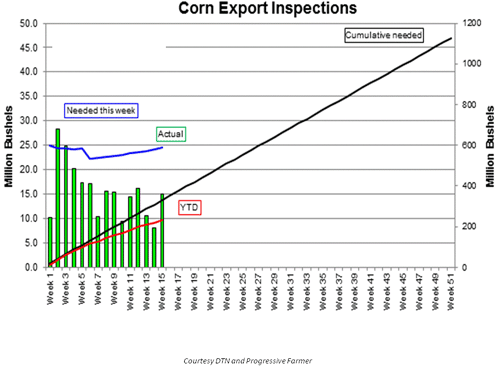
Funds were bullish 322,610 lots as of December 11; a decrease of 36,663 contracts from last week.
Commercial traders continue to indicate a less-bullish outlook by their spreading. The market remains
fairly neutral in a sideways pattern. Corn users could find some buying opportunities soon. On Monday
the national average basis narrowed 2.0
¢
/bu from last week to -8.0
¢
/bu under CBOT March futures.
SOYBEAN futures on the Chicago Board of Trade (CBOT) closed mixed on Monday. JAN’13 futures
closed at $14.962/bu; up 2.0
¢
/bu. The MAR’13 contract closed at $14.882/bu; down 3.25
¢
/bu. NOV’13
futures closed at $13.190/bu; up 1.5
¢
/bu. Strong soybean milling and fundamental demand are
maintaining the bullish market. Additionally, support was found from buying from both commercial and
non-commercial traders leading to a solid rally in the deferreds. Exports were supportive with USDA
putting soybeans-inspected-for-export at 36.990 mb vs. estimates for 40-46 mb. Exports continue bullish
with 18.3 mb needed this week to meet USDA’s demand projection of 134.5 bb. Please see chart:
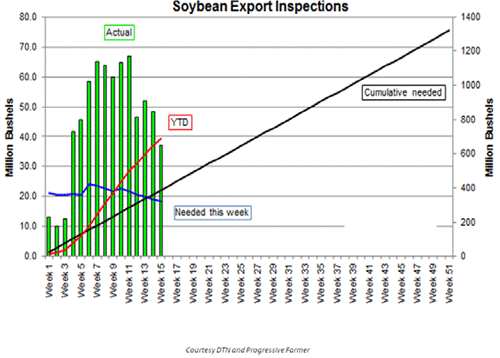
Cash soybeans narrowed 5.0¢/bu from last report with the latest national average soybean basis being placed at -26.0¢/bu under the Chicago January 2013 futures contract.
WHEAT futures in Chicago (CBOT) closed down on Monday. MAR’13 wheat futures finished at $8.080/bu; down 6.0¢/bu. The JULY’13 contract closed at $8.272/bu; down 5.75¢/bu. Wheat futures moved lower amid thin volume. Both commercials and non-commercials failed to show up in the wheat pit. Technically speaking the market shows signs of moving lower in the near-term. Fundamentally global wheat stocks are ample. Exports were supportive with USDA putting wheat-inspected-for-export at 16.355 mb vs. estimates for 11-16 mb. Basis levels for wheat were steady-to-firm. The Soft Red Winter wheat basis index was placed at -34.0¢/bu under CBOT March futures; 5.0¢/bu better than last report. Hard Red Winter Wheat basis index was placed at -48.0¢/bu under Kansas City March futures; 6.0¢/bu cents over last report. Hard Red Spring Wheat average basis index was placed at -53.0¢/bu under the Minneapolis March futures contract; 3.0¢/bu better than last week at this time.
DAIRY CLASS III futures on the Chicago Mercantile Exchange (CME) closed up on Monday. The DEC’12DA futures closed at $18.63/cwt, up $0.04/cwt. The MAR’13DA contract closed at $18.74/cwt; up $0.08/cwt. MAY’13DA futures closed at $18.75/cwt; up $0.02/cwt. Class III futures were supported in thin volume. Pits sources said they were more focused on long-term trends since most of the 2012 buying activity seems to over. Milk production continues to improve in areas where weather patterns are mild. Cheese futures were steady-to-firm Monday with barrels posting mild gains. Buyers and sellers remain cautious before schools let out for the holidays. Butter prices have also stabilized in lazy trading prior to the end of the year. Most all holiday orders have been filled. Product movement now is mostly replenishing wholesale supplies shipped to retail outlets. Class III futures were: 3 months out = $18.27/cwt ($0.03/cwt higher than last report); 6 months out = $18.51/cwt ($0.20/cwt higher than a week ago); 9 months out = $18.59/cwt ($0.19/cwt higher than last Monday); and 12 months out = $18.55/cwt ($0.16/cwt over last report). This week the variable cost of production for the average North Carolina conventional 200 cow dairy with a 23,000 lb average is $22.45/cwt; $0.30/cwt higher than last Monday … but with better prices. The price sensitivity table below illustrates different returns/cow relative to varying increases and decreases to both milk prices and inputs costs over total Variable Costs for the same NC farm.

LIVE CATTLE futures on the Chicago Mercantile Exchange (CME) closed up on Monday. DEC’12LC futures closed at $129.000/cwt; up $2.100/cwt. APR’13LC futures closed at $137.575/cwt; up $0.800/cwt. The AUG’13LC contract closed at $132.925/cwt; down $0.825/cwt. Expectations for tighter supplies in the near-term and possible snow storms in the Great Plains states were supportive. Hard, cold weather makes it difficult for cattle to put on weight as efficiently as mild weather does. Show lists are expected to shorten. Fat cattle prices were also supported by expectations processing work weeks would be shortened. Fewer slaughter days will most likely reduce supplies at the retail level in the near-term pushing up wholesale prices. Late Monday USDA put wholesale boxed beef at $194.86; up $0.17/cwt. Cash cattle were called $1-$1.50/cwt higher. According to HedgersEdge.com, the average packer margin was raised $40.95/head to a negative $28.50/head based on the average buy of $123.69/cwt vs. the breakeven of $121.23/cwt. Monday afternoon USDA put the 5-area average at $124.41/cwt. Please see graph:
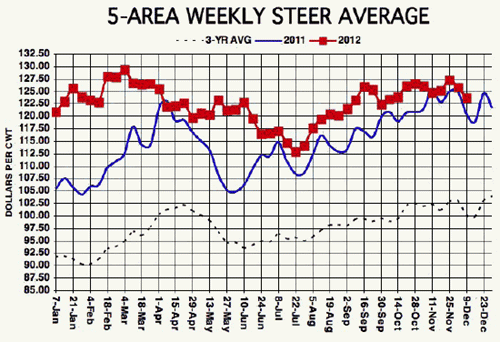
FEEDER CATTLE at the CME finished up on Monday. JAN’13FC futures closed at $154.250/cwt; up $1.175. APR’13FC futures closed at $157.650/cwt; up $1.300/cwt. The AUG’13FC contract closed at $162.550/cwt; up $0.600/cwt. Feeders finished higher amid weakness in corn futures. Lower corn prices translate into lower input prices for the feeder cattle buyer. For Monday 12.17.12 estimated receipts at the closely watched Oklahoma City market were put at 4,440 head vs. last week’s 5,310 head and 4,545 head this time last year. Compared to last week feeder steers were steady while feeder heifers were $1-$2/cwt higher. Steer calves were $3-$6/cwt higher; heifer calves $1-$3/cwt higher. Demand was considered good for all classes.
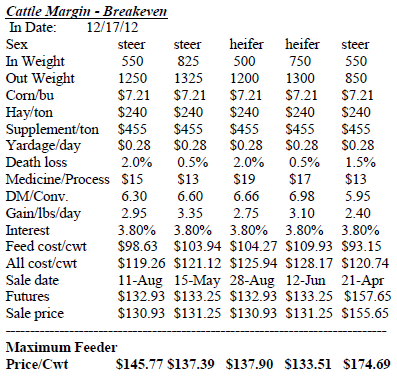
This table shows the maximum price a producer could pay for feeder cattle and still break even, assuming the costs and conversion/performance factors listed above. Producers should remain aware that calculations are based on averages. Courtesy DTN.
The CME feeder cattle livestock index was placed at 148.10; up 0.88. Please see chart:
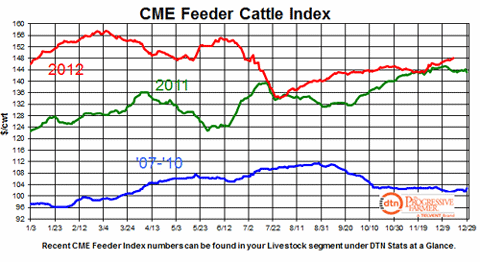
LEAN HOGS on the CME finished down on Monday. The FEB’13LH contract closed at $84.750/cwt; down $0.650/cwt. APR’13LH futures closed at $89.800/cwt; down $0.600/cwt. The JUN’13LH contract closed at $99.250/cwt; down $0.600/cwt. Lean hog futures finished lower on follow-through from Friday on weak wholesale demand and uncertainty over fears that pork supplies will swell in 2013. Lower corn prices were supportive. Pit sources told me today the market is really waiting on USDA’s hogs and pigs report due out December 28. Chart signals continue to indicate a sideways market stalling on unclear demand signals. Cash hogs were stead-to-flat. Contrary to beef, slaughter schedules are not expected to shorten for the holidays with many processors extending work hours into Saturdays. Late Monday USDA put the lean pork cutout at $82.54/cwt, up $0.31/cwt. According to HedgersEdge.com, the average packer margin was lowered $1.00/head to a negative $1.90/head based on the average buy of $59.66/cwt vs. the breakeven of $58.98/cwt. The latest CME Lean Hog index was estimated at 82.02; down 0.57.

This table shows the maximum price a producer could pay for feeder pigs and still break even, assuming the costs and conversion/performance factors listed above. Producers should remain aware that calculations are based on averages. Courtesy DTN.








